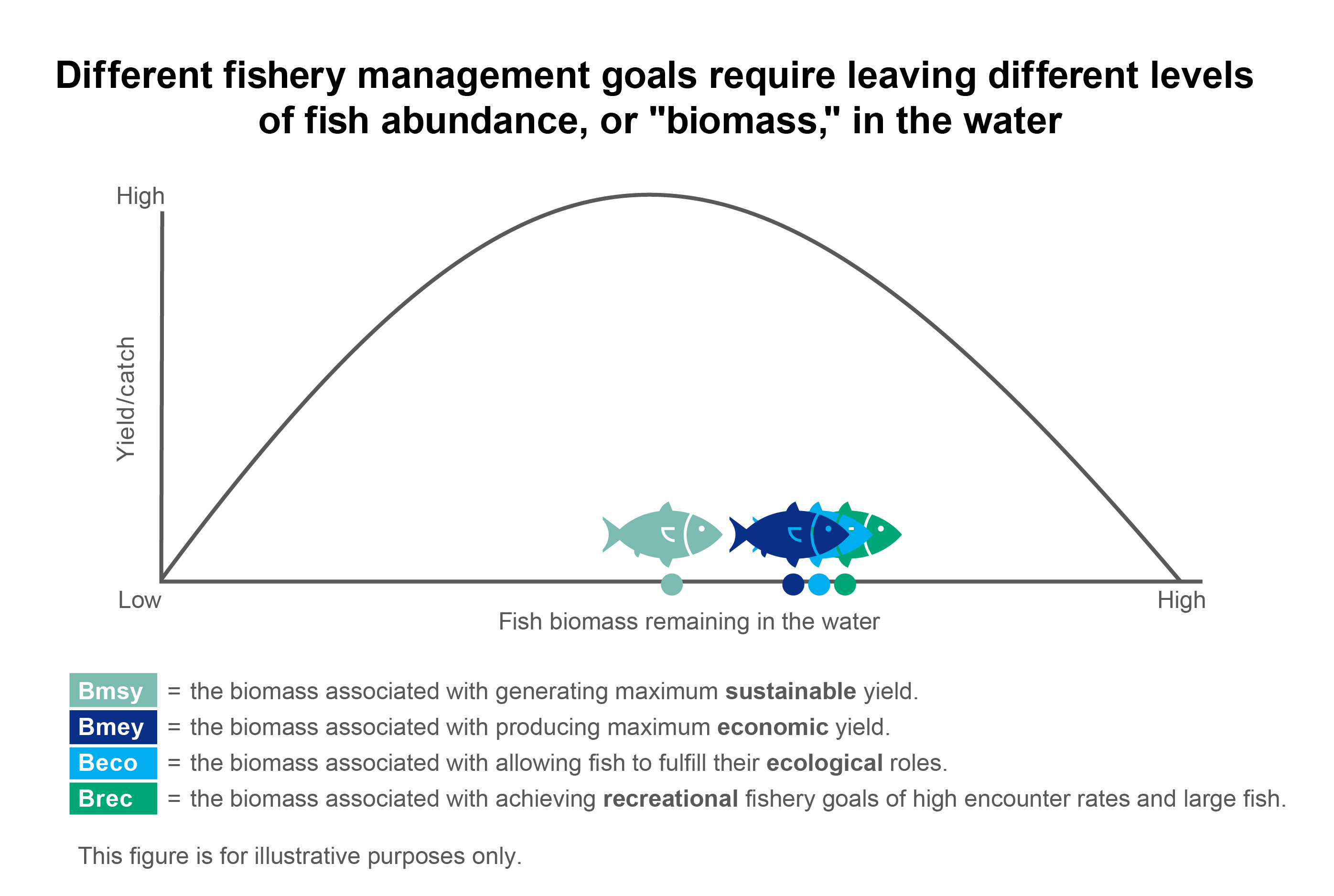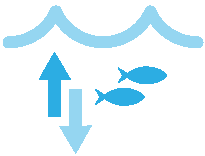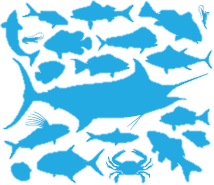The trouble with not having a goal is that you can spend your life running up and down the field and never score. If you don’t know where you are going, any path will get you there. Be careful of what you wish for.
There are lots of sayings about goals, because it’s so important to get them right. Fisheries management is no different – having clear goals is essential, because they should guide every decision.
It may seem obvious what the goals of fisheries management are – sustainable yields, stable jobs, and ecosystem health are often cited. Fisheries often have multiple objectives and achieving them requires varying amounts of fishing mortality and stock abundance (how much fish is in the water, and how much we are taking out) (Figure 1).

For example, one objective might be maximizing the amount of landings (or yield) that the fishery can sustainably produce over many years. This is known as Maximum Sustainable Yield, or MSY. MSY is often associated with stock abundance levels that are approximately half of the abundance levels that would exist if no fishing took place at all. So for most species, but not all, fishing at MSY would mean catching half of what is in the water, and leaving the other half to sustain the future of the stock. MSY can be associated with relatively high levels of fishing mortality if the stock is fairly productive.
However, if another objective of fishery management is to maximize profits, it may be necessary to reduce catch in order to allow the stock abundance to increase to higher productivity in the future. Fishing costs tend to go down when abundance goes up as the fish are easier to catch. If the fishery includes recreational fishing businesses that value high encounter rates and big fish, fishing mortality may have to be reduced even more because recreational fishermen are likely to get more bites and catch more and larger fish (thus achieving the main goal of a better recreational fishing experience) when stock abundance is higher.
Protecting the ecosystems that support fisheries should always be an important objective of fishery management. This means leaving enough fish in the water (i.e., adjusting fishing mortality) not just to maintain desired yields, but also to ensure that the fish can fulfill their ecological roles such as preying on other species, serving as food for predators and moving energy and nutrients through the ecosystem.
Goal setting should always be a stakeholder driven, inclusive process. Together, stakeholders should consider all possible desired goals for the fishery, both fishery sustainability and climate resilience goals, and then narrow them down to a list of goals that can be addressed with available capacity and resources. Trade-offs between goals should be acknowledged and addressed – when there are trade-offs (e.g., between increasing fishery profits and decreasing fishing mortality to protect or restore a vulnerable stock) stakeholders must either determine which goal they value more highly, or develop a compromise goal that does not result in tradeoffs (e.g., increase fishery profits by increasing demand for more resilient stocks that can be harvested without negative impacts on vulnerable stocks). The Downloadable Workbook includes a brief worksheet that can help stakeholders define goals.
As discussed in Step 1, climate change is altering the fundamental ecological conditions on which our understanding of fishery functioning and stock health are based. Given increased uncertainty, and potentially drastic changes to species’ ranges and productivity rates, it is critical that we begin to develop goals that are in harmony with what is going to be possible in a given fishery in the future. In other words, we must “benchmark forward,” rather than looking to the past for indicators of the efficacy of our management decisions.
But how can we balance this need to move our fisheries and fishing communities toward climate-informed goals, which may involve moving away from fishing the way we are familiar with it, and the need to bring our current fishing activities into alignment with current and future system boundaries, so that we can continue to meet current and near-term livelihood needs?
We suggest engaging in a participatory process to clearly articulate separate “Fishery Sustainability Goals” and “Climate Resilience Goals” for the fishery and community. Fishery Sustainability Goals might center around reduction of egregious impacts (like dynamite fishing), increasing fishing safety and/or profits, and/or the alignment of fishing pressure with the current regenerative capacity of the biophysical system (i.e., not catching more fish than are added to the population each year). Climate Resilience Goals may center more on things like the restoration of species diversity to build system resilience, the protection of “habitat corridors” to facilitate species range shifts, the sustainable management of emerging stocks, and/or capacity building and alternative livelihood development to help fishers adapt in response to climate-driven changes.
We list several example fishery objectives, organized loosely into Fishery Sustainability and Climate Resilience Goal categories, in Table 1.
Step 2, Table 1. Examples of common Fishery Sustainability and Climate Resilience Goals, along with relevant management objectives.
|
Goal Category |
Biological/ Ecological Objectives |
Economic Objectives |
Social/ Cultural Objectives |
|
Fishery Sustainability Goals |
Remove egregious system impacts (e.g., dynamite fishing, cyanide fishing) |
Decrease waste or discarding |
Decrease conflict |
|
Limit fishery truncation of age structure (i.e., stop catching juveniles and megaspawners) |
Decrease fishing costs |
Increase fishing safety |
|
|
Protect essential habitat |
Increase price per fish |
Increase or develop community involvement in management |
|
|
Protect spawning stock biomass |
Increase fishing profits |
Increase or maintain local fishing jobs |
|
|
Protect essential behaviors and functional diversity |
Increase production |
Protect cultural fishing traditions |
|
|
Decrease bycatch and/ or avoid serial depletion |
Increase product quality |
Improve equity of the distribution of benefits and risks from the fishery |
|
|
Climate Resilience Goals |
Improve ecosystem health, resilience, and biodiversity |
Increase fishing/ supply chain efficiency and flexibility |
Improve community livelihoods and wellbeing |
|
Facilitate species adaptive capacity by protecting habitat throughout temperature corridors |
Increase flexibility and adaptability of fishers |
Improve community resilience and transformational capacity |
|
|
Facilitate the sustainable harvest of emerging stocks |
Expand livelihood options |
Support vulnerable and marginalized groups through transition |
In order to achieve goals like these, I it will be necessary to identify the different steps required to move a fishery toward them. Actions aimed at expanding livelihood options in a community may be very different from those aimed at increasing product quality. It will thus be necessary to clearly articulate what can be done with current levels of capacity, and to explicitly incorporate plans to move toward harder to reach goals into the adaptive management process.
While it may be tempting to think of Climate Resilience Goals as “longer-term” targets that can be de-prioritized for now, this kind of thinking may be quite risky. It is often the case that building climate resilience requires taking certain enabling steps as soon as possible. For example, in order to sustainably harvest emerging stocks, it will be necessary to first create and implement a monitoring system that will be capable of detecting the presence of new species in the area and, ideally, of determining when they have become established enough to begin harvesting.
When working in a multispecies fishery, where multiple species are simultaneously captured by the same gears, there is another factor that must be considered during the goal setting process – the risk of serial depletion. Serial depletion refers to the depletion of individual stocks within a multispecies fishery, one after another. Typically, large, tasty fish that are easy to catch are depleted first. Then smaller, more cryptic fish are depleted. Finally, small pelagic fish and invertebrates are fished down. This can happen when species that differ in their productivity and susceptibility to fishing are fished at the same rate. Species with lower productivity and higher susceptibility like grouper that aggregate to spawn will be depleted first. Species with high productivity that are more difficult to deplete like sardines or lobsters are more resilient and can persist even when fishing effort is high. Serial depletion can happen even as total catch remains high, masking the depletion of individual stocks and setting the fishery up for collapse.
Stocks that are vulnerable to depletion and are caught in multispecies fisheries are called “weak stocks.” The presence of weak stocks in a multispecies fishery makes management complex because protecting these stocks from overfishing often limits fishing opportunities on target stocks, reducing the economic potential of the fishery. Thus, the real challenge in a multispecies fishery is to avoid depleting weak stocks while still maintaining good economic outcomes (jobs, profits, etc.).
Another problem is that species in a multispecies fishery are not only caught together, they also interact with each other in many ways that can have a dramatic effect on management outcomes. This means that trying to manage a single stock while ignoring the others could result in accidental overfishing or a reduction in total system productivity. Furthermore, serial depletion can not only result in fishery collapse, it can also result in ecosystem collapse. All the species in an ecosystem community play important roles and depend on each other to keep the system functioning. Many marine ecosystems exhibit tipping points, at which large changes occur in response to relatively small changes in drivers. Because fish are important regulators of ecosystem structure and function, serial depletion of individual stocks can be an important driver of ecosystem state change.
So in multispecies fisheries goals must not only include the production of good yields from single stocks, they must also include the avoidance of serial depletion and the prevention of adverse impacts of fishing on marine ecosystems.




